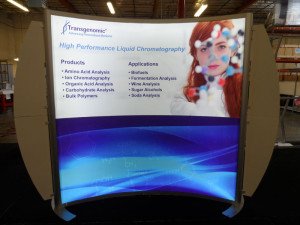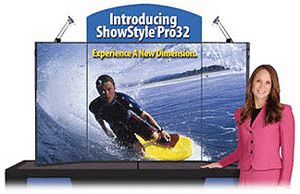Goofs, Gaffes, and Blunders to Avoid in your Trade Show Display
Whenever I wander around a trade show, I can’t help evaluating all the trade show booths on display. It’s just a part of the business. And one thing that always strikes me is when a booth is overall 90% great, but they make one or two seemingly-minor mistakes that end up undercutting their other work. 
Trade show displays are a very holistic sort of marketing tool. Even more than in most areas of customer outreach, it’s vital that the total package be well-planned and of high quality throughout. Cutting corners, even in seemingly-minor ways, can ruin the ROI on your trade show display.
So, we’d like to offer this reminder of a few areas where small goofs can snowball into big problems. These are the little things that can make the difference between a successful trade show appearance, and a costly waste of marketing funds.
Don’t Say “Whoops.” Avoid These Five Big Trade Show Display Mistakes!
1 – Blocking The Entrance
This is such a tiny layout issue, but it’s so huge. Do NOT put anything large and imposing at the front of your trade show booth space – not if you want people walking into the space! Even a table, set near the entrance, can deter people from walking inside because it creates a barrier, both physically and psychologically. 
Our innate social cues on “how to do business” tell most of us to remain on one side of a table or desk, rather than going past it. Desks and tables often delineate “my side” vs “your side” and people tend to follow those rules without realizing it. Don’t stand behind the tables, get out in front and mingle!
Otherwise, if you’re using layout to encourage visitors to only follow one path through your display, make sure it’s clearly laid out with plenty of contextual clues, like lighted arrows or footstep silhouettes on the ground. Often, a seeming unclear display layout can be fixed with a quick bit of signage or other subtle ways of saying “Walk HERE.”
2 – Typos
It’s very simple: You can never have enough eyeballs looking over your printed copy. You have no idea how many booths I’ve seen that end up undercutting their message through something as simple as poor use of apostrophe’s [sic; just like that].
It immediately sends the message: “We don’t pay enough attention to detail.”
A lot of people don’t like to hear that their $300 banner stand needs to be reprinted because there’s a simple grammatical error or misspelled word or name, but these kind of simple mistakes can cause problems – especially in the era of smartphones. At any trade show, there will always be someone wandering around deliberately looking for mistakes they can point out and mock on social media.
And depending on the mistake, a single “viral” social post mocking a company’s booth can easily overpower the original messaging.
There’s no defense against these folks except not giving them ammunition. Do not put anything with type up on your trade show display unless multiple people have all looked over the copy and agree there are no errors.
3 – Uneducated Booth Staff
This tends to especially be a problem when companies are dealing with hired\outsourced booth staff rather than bringing their own workers. Still, it can strike just about anywhere.
Your booth staff must, must, must be able to answer at least most of the questions that visitors have about your products. They are your key brand ambassadors, and the people most directly responsible for creating a good impression of your company in the minds of visitors.
A bevy of booth babes might distract people or invite more photographs, but the actual buyers will notice if no one manning your booth actually seems to understand the product. Those are the people you want to impress, not lonely hearts wandering by.
After all, what’s your message, that your product is so complicated that not even the manufacturer can find people that understand it?!
Your booth staff should be fully briefed on your products, as well as your company history and philosophy. Additionally, we strongly recommend they have a “life line” of some sort – a contact back at the hotel or in the office who’s “on deck” and ready to quickly field questions the front-line staff can’t answer for themselves.
Otherwise, if a visitor gets the idea that your staff doesn’t understand the products, they’re not likely to become a viable lead.
4 – Few Or No Hands-On Items
As we’ve discussed before, some surveys lately have suggested that being able to get hands-on with trade show display materials is increasingly important to visitors. They don’t want to simply pick up information, or have a stock “elevator pitch” thrown at them. They want to be able to interact with your products and, if possible, try them out for themselves.
So at this point, we consider it effectively a requirement that a good trade show booth have products, demos, or at least software mockups that people can actually interact with.
Remember, this isn’t simply about giving people toys to play with. Engagement and interaction build more cognitive and emotional links between your visitors and your business. A visitor getting hands-on with your demos is going to end up feeling more favorable towards you than one who just passively watches a pitch. (Assuming the demo works, anyway.)
5 – Poorly-Targeted Swag
We’ve said it before and we’ll say it again: Your “generic” branded items like pens or coffee mugs are unlikely to even make it out of the visitor’s hotel room, much less into their everyday use. Everyone likes having pens to give away, but if you want to see real returns from your branded items, you need to be smarter than that.
A good piece of promotional merchandise, one that actually drives leads going forward, should have some or all of the following elements:
- Direct relevance to your visitors, something designed with their lives in mind. This an area where your buyer personas become useful.
- Actual utility value, specifically for your target market. Example: Home builders would likely enjoy receiving complex engineering calculators. Home decorators would not.
- Messaging that ties the merchandise to an aspect of your business or philosophy. Be clever, or look for visual puns. If your tagline was “cutting through the clutter,” give out scissors.
- Decent build quality. Promo merch is never going to be Tiffany’s, but remember that these items reflect on your own quality. A calculator that breaks two days later, or a pen that doesn’t work, sends the wrongmessage.
- Room for messaging beyond your brand and telephone number. Find a way to tell more about yourself than the bare minimum. Virtually any surface can be used for messaging.
- Provide amusement, if nothing else. Plenty of serious companies like IBM have done well giving away toys or “executive novelties” designed to kill a few minutes between meetings.
Promotional merchandise is a fairly pricey marketing investment. Give it real thought before placing the order, to maximize its impact after the show.
There’s No Such Thing As Too Much Attention To Detail
Details truly matter in the world of trade shows, and even minor missteps can end up having significant consequences for your lead generation and ROI. Plan your trade show appearances well ahead of time, and have enough people onboard with input into the project that you can notice and correct for potential mistakes before they happen.
And as always, if you’d like to peruse our design selections or just have questions, please don’t hesitate to contact us for a quick response.
For more advice, check out our article on terrible trade show mistakes and always remember, the trade show must go on.
